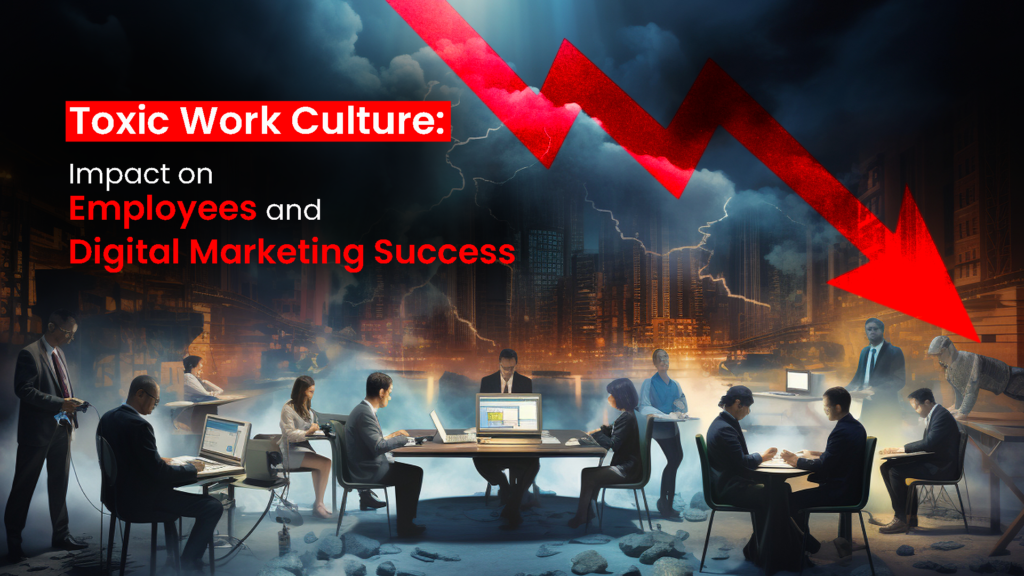The Dark Side of Corporate Culture: How Toxic Work Environments Affect Employees and Digital Marketing
In the fast-paced world of corporate business, productivity and efficiency are often prioritized above all else. However, this relentless pursuit of success can sometimes foster a toxic work culture that negatively impacts employees’ well-being and the overall health of the company. In this blog, we will explore the signs of a toxic work environment, how it affects employees, and the broader implications for digital marketing and business success.
1. Recognizing Toxic Work Culture
Toxic work culture can manifest in various ways, often going unnoticed until the damage is significant. Common signs include:
- Micromanagement: Excessive control over employees’ tasks, stifling creativity and autonomy.
- Unrealistic Expectations: Constant pressure to meet impossible deadlines, leading to burnout.
- Lack of Support: Inadequate resources, poor communication, and lack of recognition or appreciation.
- High Turnover: Frequent employee resignations, indicating dissatisfaction and a hostile work environment.
- Office Politics: Favoritism, gossip, and power struggles that create a divisive and stressful atmosphere.
These behaviors not only harm individual employees but can also erode team morale, leading to a decline in overall productivity and creativity.
2. The Impact on Employees
Employees who work in a toxic environment often experience:
- Stress and Burnout: Constant pressure and lack of support lead to physical and mental exhaustion, reducing their ability to perform effectively.
- Decreased Job Satisfaction: When employees feel undervalued or mistreated, their motivation and engagement decline, resulting in poor performance.
- Mental Health Issues: Prolonged exposure to toxic work conditions can lead to anxiety, depression, and other mental health challenges.
- Reduced Creativity and Innovation: A hostile environment stifles creativity, as employees may fear taking risks or proposing new ideas.
- High Turnover Rates: Talented employees often leave toxic environments in search of better opportunities, leading to increased recruitment costs and loss of institutional knowledge.
These effects not only harm the well-being of employees but also undermine the company’s ability to innovate, compete, and grow.
3. The Ripple Effect on Digital Marketing
These effects not only harm the well-being of employees but also undermine the company’s ability to innovate, compete, and grow.
- Brand Reputation: A company’s internal culture often reflects its external image. Negative employee reviews on platforms like Glassdoor can damage the brand’s reputation, deterring potential clients and employees.
- Inconsistent Marketing Messages: Stress and burnout can lead to errors, inconsistencies, and lackluster creativity in marketing campaigns. This can result in mixed messages and a diluted brand identity.
- Lowered Productivity: When employees are disengaged or overworked, the quality and timeliness of digital marketing efforts suffer. Campaigns may miss deadlines, or fail to resonate with the target audience.
- Reduced Customer Engagement: Digital marketing relies on understanding and connecting with the audience. Employees in a toxic environment may lack the motivation to engage deeply with customer needs, leading to less effective marketing strategies.
- Innovation Stagnation: The pressure of a toxic work culture can stifle innovation, preventing the company from keeping up with industry trends and evolving customer expectations.
4. Strategies for Improvement
Addressing a toxic work culture requires a comprehensive approach:
- Leadership Accountability: Leaders must recognize their role in fostering a healthy work environment and take active steps to promote transparency, fairness, and support.
- Employee Well-Being Programs: Implement initiatives that focus on mental health, work-life balance, and stress management to support employee well-being.
- Open Communication: Encourage open dialogue between employees and management, allowing concerns to be addressed before they escalate.
- Recognition and Reward: Regularly acknowledge and reward employees’ efforts, fostering a culture of appreciation and motivation.
- Continuous Learning: Provide opportunities for professional development, helping employees grow and feel valued within the company.
Conclusion
A toxic work culture can have devastating effects on both employees and the success of a company’s digital marketing efforts. Recognizing the signs and taking proactive steps to create a positive, supportive environment is essential for maintaining employee well-being and driving business success. Companies that invest in their employees’ happiness and growth will not only foster a healthier work culture but also see significant improvements in their digital marketing outcomes and overall business performance.
By prioritizing a positive work environment, companies can ensure that their digital marketing strategies are executed with the creativity, consistency, and innovation needed to thrive in today’s competitive market.


